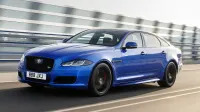All-electric Jaguar XJ coming soon on platform shared with ‘Road Rover’

Nick Rogers, JLR’s product engineering boss, said electric MLA vehicles will get 90.2-kWh batteries that return range of up to 400 kilometers (292 miles) on the European cycle. That would effectively be the same size battery as the I-Pace, which rides on its own one-off platform, and the same range; in the U.S., the I-Pace is rated at 234 miles. It’s said the XJ’s design, produced by former Jaguar design chief Ian Callum and his team, has already been cleared. It swaps the four-door body for a five-door, a la the Audi A7, and introduces a new design language for the car and the carmaker.
Car and Driver says the new statement sedan aims to be “a cutting-edge alternative to the BMW 7 Series and Mercedes-Benz S-Class,” and Autocar saying it will “remain Jaguar’s flagship in preference to a large SUV, such as the rumored J-Pace.” The point of introducing the EV first is to establish the car’s technology and sporting credentials — hopefully before the Porsche Taycan and Audi E-Tron GT arrive.
Eventually, an ICE version of the XJ powered by an Ingenium inline-six should come; that will welcome buyers not ready to make the all-EV switch, a necessary move in keeping with the XJ’s competition for global sales with the S-Class and 7 Series. However, leaving room in the design for a conventional drivetrain will force compromises that the all-electric competition doesn’t face.
Production of the current XJ ends at the Castle Bromwich facility on July 5. The new sedan is slated to be “announced in the near future” and built at JLR’s plant in Solihull, which assembles Land Rover products. The same MLA platform will support a road-focused Land Rover as a sibling to the XJ, dubbed the “Road Rover” internally.
The “large SUV” mentioned in the Investor’s Day presentation would be the next-gen Range Rover, penciled in for 2021. The Range Rover models will make the most use of the MLA platform, coming in ICE, plug-in hybrid, mild hybrid, and all-electric versions employing at least four nameplates. The PHEV models get a 13.1-kWh battery good for 50 km (31) miles of EV range. Taking the opposite tack to Jaguar, Range Rover is expected to launch its EV model later in the cycle, because “Land Rover wants the first electric Range Rover to be a stand-alone model.”




